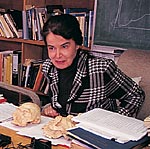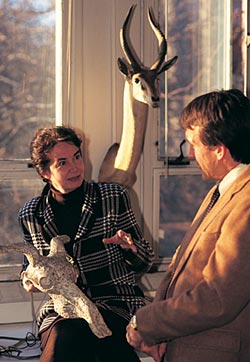Interview: Elisabeth Vrba

Elisabeth Vrba always knew she would be a scientist. Her undergraduate degree at the University of Cape Town was in mathematical statistics and zoology. Currently professor of paleontology and biology at Yale University, Dr. Vrba describes her career and research in the spirit of two grand principles: Earth and life evolved together, and nothing in biology makes sense except in the light of evolution. Her controversial turnover-pulse hypothesis has enlivened debate and research on the effect of past climatic changes on macroevolution, especially seminal events in human evolution. Larry Mitchell interviewed Dr. Vrba in her office at the Peabody Museum of Natural History at Yale.
This unit on biological diversity follows our chapters on evolutionary principles. Could you help us make the connection between evolution and diversity?
I find that the best evidence for evolution is the diversity of living organisms, the distribution of characteristics among species, and the hierarchical patterns of diversity. For instance, all of life has DNA and RNA, and all eukaryotes have nuclei and organelles. You could think of these common features as creations of a higher power or, scientifically, as the result of life having evolved on a single tree. This is a very simple hypothesis, but the evidence supporting it is overwhelming.
Tell us some of the highlights of your career since you began graduate studies.
In 1966, my husband and I were living in Pretoria, and I was looking around for a Ph.D. topic. I remember one day my old friend Bob Brain said to me, "Well look, there's this pile of rocks full of fossils from the Transvaal caves, and they still have to be cleaned. This is hard work, and nobody wants to do it." Not having much money, I asked, "Can you pay me something?" and he said, "No. Not in the beginning." I still had some money, so I said I would do it for 6 months to see if I could manage. And then I got really keen on paleontology! You see, I was working with materials from some of the most famous fossil sites in South Africa, especially in human evolution. Some of the fossil specimens you see here on my desk are plastic casts of actual fossils that came from two caves in which I did my own excavating. You will recognize some of the names: a robust-bodied australopithecine, sometimes called Paranthropus, and one that many workers think is closer to the lineage of the genus Homo; that is Australopithecus africanus.
About how old are these fossils?
This specimen of Australopithecus africanus would have lived about 2.5 million years ago, and Paranthropus, which was found with fossils of Homo, would be about 1.8 million years old. At that point, there were two prominent lineages, and we can see them side by side in the same deposits in South Africa and also in East Africa.
What exactly does the term lineage mean in an evolutionary sense? Is it something different (more specific) than a line of descendants from a particular ancestor?
A lineage, as many of us now use the term, is synonymous with a clade, or a monophyletic group-a single ancestral species and all of its descendants. For instance, by the lineage of the genus Homo, we mean that there is a common ancestor that belongs to Homo, and a number of descendants from that. There may have been a lot of branching after that first ancestral Homo—for instance, into Homo habilis, Homo erectus, Homo neanderthalensis, and Homo sapiens—and that entire clade, or monophyletic group, from a single ancestor would be called the lineage of the genus Homo. The term lineage can also be used for a single species (of sexually reproducing organisms). For instance, a single lineage would be from the time Homo sapiens started, through and including the present.
A major focus of your research has been to use the fossil record to analyze the effects of past tectonic and climatic events on species diversity. Tell us more about this.
We are very interested in macroevolutionary processes, speciation, and evolutionary change in relation to paleoclimates and paleoecology. In other words, we look for evidence in the fossil record of a relationship between morphology, phylogeny, and patterns of associations of fossil species and major changes in the physical environment, such as climate. Why did some lineages change hardly at all, while others show massive long-term trends? I am especially interested in the environmental context of assemblages of fossil mammals, and in environmental influences on human evolution.
 Please explain your turnover-pulse hypothesis.
Please explain your turnover-pulse hypothesis.
Quite simply, my idea of turnover-pulse is that major physical changes on earth, such as climatic shifts and tectonism, underlie periods of major change in the biota. In other words, environmental pulses correlate with abrupt increases in speciations and extinctions, specific times in Earth's history when many species vanished and others appeared. With my special interest in human evolution, I have looked in the fossil record of phylogenetic patterns in other species that were contemporary with our early ancestors. Working in Africa, I found that antelopes make up a large portion—60 to 80 percent—of the mammalian fossils in the same strata where we find our early ancestors, the australopithecines. Antelopes are good indicators of paleoclimates. For instance, some evidence in the fossil record indicates that about 2.5 to 3 million years ago many species of antelopes that inhabited moist woodlands in southern Africa disappeared and were replaced by new species that lived in drier, more open areas we call savannas. Fossil evidence also points to a radiation of hominid species on African savannas at about the same time. I would predict that as we learn more about macroevolution, we will find that recurrent pulses of varying intensity are an important part of the history of life.
It seems that the turnover-pulse idea closely resembles the concept of punctuated equilibrium.
Punctuated equilibrium was articulated by Eldredge and Gould in a 1972 paper (Eldredge, N. & Gould, S.J. 1972. Punctuated equilibria: an alternative to phyletic gradualism. Pp. 82-115, in Models in Paleobiology, T. Schopf, ed., W.H. Freeman, San Francisco). Punctuated equilibrium and turnover-pulse resemble each other only in some respects and differ substantially in others. Resemblances include that both argue that speciation most often occurs in small allopatric populations ("allopatric speciation," that is, speciation in geographically separated populations). Both predict a pattern of morphological change in a given lineage through time that is episodic and mostly associated with speciation (that is, with lineage splitting).
Could you summarize some of the current debate about turnover-pulses?
As any scientist knows, controversy is essential, and the turnover-pulse idea has generated a great deal. The current debate is mainly about the timing of events and in some cases about the methods used to determine whether pulses actually occurred. There will always be new information challenging what has gone before, but the important thing is to keep the research moving forward. We have much, much more to learn about the evolutionary events that gave rise to all the diversity of life than we know at present.
Often scientists seem to work on one small branch of a research area. But your work involves a great range of subjects.
It's sad to see specialists in different fields, each with fantastic information and ideas, limiting themselves because they never speak to each other. When you cross that boundary and say, "Tell me what you've got" and they say, "Well, look at this," you suddenly realize, Oh, that is so relevant to what I'm doing!
From the beginning, I made up my mind that if there's ever a subject that I'm interested in I'm going to do my level best to find out about it, even if I'm not, so-called, trained. After all, what is training? You've got to start somewhere. I'm very interested in how Earth and life evolved together, and so I've had to learn about geology and climates as well as paleontology.
Great discoveries have always been made at the intersections of disciplines. Reading Malthus, Charles Darwin was looking at demography; he was also looking at the works of an economist, Adam Smith—quite different—and at the works of the Belgian statistician Adolphe Quetelet. And then, out came the idea—natural selection. There are many examples of people working at intersections, simply to get a different perspective. It's like getting in a boat and traveling to the other side of a river and looking to see what it's like from there. I keep telling my students they've got to be open and try to learn about different things. I want them to have more than one kind of skill. I firmly believe in interdisciplinary work, and that's where all the excitement lies.
Speaking of Charles Darwin, ecologists are fond of claiming him as one of their own, so to speak. What do you think about that?
Yes, that's absolutely correct. Chief among Darwin's many contributions is natural selection, which he saw resulting from an interaction between organisms, their particular features, and the environment. This is the very core of ecology. Also, Darwin was not just an arm-chair philosopher; he went out and looked at nature, at the interactions, and he had a very broad view of the living world and the environment.
Do you have any advice or counsel for students beginning a career in life science?
I think the first and most important thing is that you have got to love what you do. And what I mean by that is don't be pushed by your parents or by what your peers think. Don't ask, "Is there money in it? Is it going to land me a job?" First ask, "Can I love this? Is my heart in it?" Don't get sidelined, don't get worried about difficulties. Just work hard. There are always difficulties and hurdles, not least of which is one's own inability to concentrate, to focus, to commit oneself. That's perhaps the biggest hurdle you ever have to overcome. You've got to personally make a commitment: I love this and I want to do it, and it's worth it. I'm going to put my energy there.
©2005 Pearson Education, Inc., publishing as Benjamin Cummings